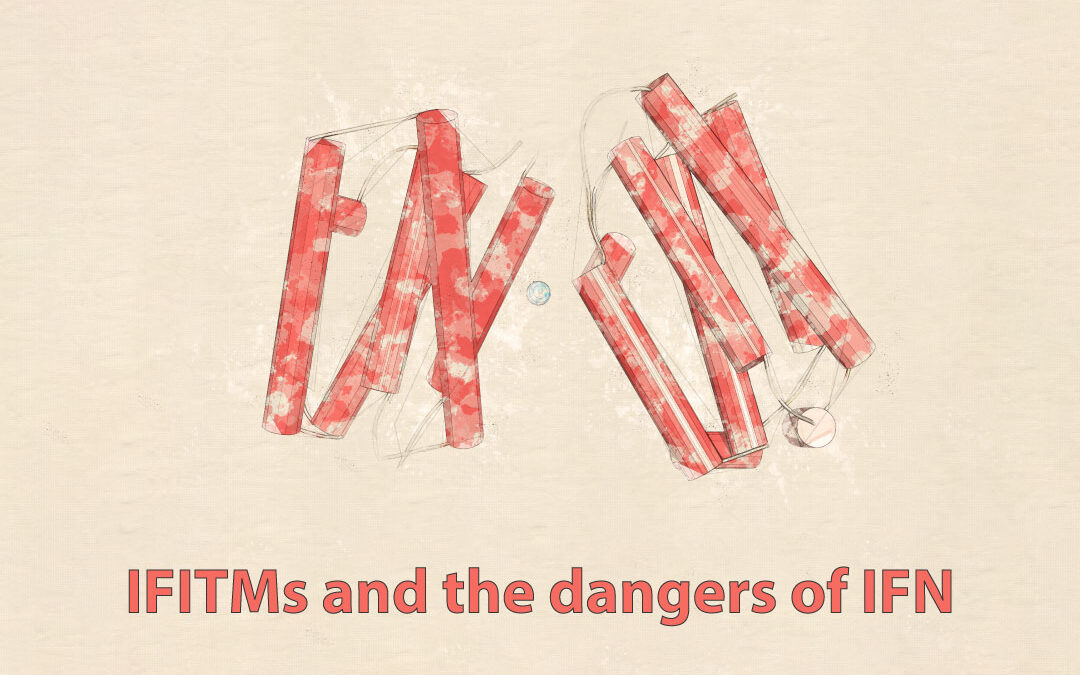Our cells use a wide variety of mechanisms to prevent virus infection. These mechanisms are usually mediated by proteins that are upregulated upon induction of interferon. Among these interferon-stimulated effectors, the IFITM (interferon-induced transmembrane) proteins comprise a family of antiviral restriction factors that can prevent viral fusion with cellular membranes (the plasma membrane or endosomal membranes), thereby stopping viruses from replicating within cells.
At least three human IFITM proteins have been shown to have antiviral activity: IFITM1, IFITM2, and IFITM3. Because of its different sorting motifs, IFITM1 mostly resides at the plasma membrane, whereas IFITM2 and IFITM3 accumulate in the endolysosomal compartment. These proteins potently restrict cell entry of an extraordinary variety of viral pathogens important to human health, including dengue virus (DENV) and influenza A virus (IAV), although a few viruses appear to be able to escape this barrier (e.g., the arenavirus that causes Lassa fever).
Beyond IFITM proteins’ antiviral activity
IFITM proteins are expressed at various basal levels in multiple cell types and – beyond their antiviral activity – their physiological and cellular functions remain poorly characterized. Transgenic mice missing the IFITM proteins are more sensitive to various viral infections but exhibit no overt abnormalities (except for being slightly overweight).
The beneficial effect of IFITM proteins can, however, become harmful if IFITM protein expression exceeds safe levels in the placenta, as shown by Buchrieser et al. in this Science paper.
The placenta is both a surface for exchange and a barrier between mother and fetus; it delivers nutrients needed for fetal growth, produces hormones, and protects the fetus from microbes and the maternal immune system. The external layer of the placenta, known as the syncytiotrophoblast, is composed of cells that fuse together, forming giant cells that are optimized for the placenta’s barrier and exchange functions. The syncytiotrophoblast of the human placenta is an epithelial barrier that interacts with maternal blood and is key for the transfer of nutrients and other solutes to the developing fetus. The syncytiotrophoblast is a true syncytium and fusion of progenitor cytotrophoblasts is the cardinal event leading to the formation of this layer. The fusion of cytotrophoblasts into the syncytiotrophoblast layer is essential for continued pregnancy and is mediated by a protein called Syncytin. Syncytin – which is specifically expressed in the syncytiotrophoblast layer – is a membrane protein derived from the envelope gene of an endogenous retrovirus (ERVs) of the HERV-W family that has been captured by mammals. The capture of syncytin genes, sometimes as pairs (syncytin-1 and -2 in humans and syncytin-A and -B in mice) occurred independently from different ERVs in diverse mammalian lineages 10 to 85 million years ago.
The second life of IFITM proteins
In the 293T human cell line and trophoblast-like BeWo human choriocarcinoma cells, the authors found that IFITMs reduce syncytin-mediated cell fusion.
Next the authors tested whether IFITMs block fusion in mouse embryonic fibroblasts (MEFs) by comparing wildtype mice and mice in which Ifitm genes have been knocked out (IfitDel mutant mice). When these MEFs were cotransfected with syncytin-A and GFP plasmids, Syncytin-A induced many large GFP+ syncytia (up to 20 nuclei) in IfitDel mutant mice, whereas fewer and smaller syncytia were produced in the wildtype MEFs. Re-introducing IFITM3 restored resistance to fusion in the IfitDel mutant MEFs.
In human midterm placental chorionic villi explants, addition of IFN-ß induces multiple defects. In these same explants, IFN-ß has been reported to upregulate IFTM1. Following this logic, the authors next tested the impact of IFN-ß on primary villous cytotrophoblast (VCTs), which, when cultured, will spontaneously differentiate into multinucleated syncytiotrophoblast. Indeed, IFN-ß induced syncytin-2 (but not syncytin-1) transcript levels and inhibited VCT fusion. Next, the authors compared the effect of injecting Poly-IC (which induces IFN and fetal retardation and resorption) into pregnant wildtype, and IfitDel mice. Consistent with their in vivo findings, injection of Poly-IC resulted in resorption of wildtype fetuses but not IfitDel fetuses.
Taken together, this work uncovers a previously unknown function for the IFITM anti-viral restriction factors; IFITMs impair the fusogenic activity of syncytins that is required for the syncytiotrophoblast formation and maintenance. The discovery of this novel function for IFITMs is important because it suggests a molecular mechanism for IFN-mediated disorders, pregnancy complications associated with genetic and autoimmune interferonopathies, and the serious birth defects associated with Down syndrome in trisomy 21 patients.
The authors close by suggesting the possibility of blocking IFITMs as part of a strategy to prevent pregnancy complications linked to interferonopathies. However, given their critical and broad-spectrum antiviral role, this suggestion may cause more problems that it solves. A more sensible approach would be to focus on the causes of chronic and uncontrolled IFN upregulation. Solve this, and IFITMs are unlikely to cause harm.
The take-home message from this interesting work: IFITMs play an important role blocking viral attempts to infect, but misregulation of IFITMs can inhibit the vital work done by syncytin (a mammalian protein of viral origin) during placental development.




